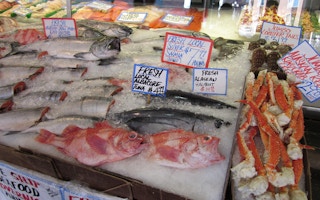Seafood is an essential staple in the diets of people around the world. Global consumption of fish and shellfish has more than doubled over the last 50 years, and is expected to keep rising with global population growth. Many people assume that most seafood is something that we catch in the wild with lines, trawls and traps. In fact, aquaculture (aquatic farming) accounts for just over half of all the seafood consumed worldwide.
Today aquaculture is the fastest-growing food sector in the world. Most farmed seafood is currently produced in freshwater environments such as ponds, land-based tanks and raceways, but some producers are expanding to the open ocean.
Aquaculture dates back thousands of years, but has only recently become an essential part of our global food system. However, most of the world’s wild fisheries are already fished at their maximum sustainable yield, so aquaculture will have to be the primary source of our seafood now and into the future.
This means that we need to understand how to farm fish and shellfish sustainably. We do not have broad-scale understanding today about the ecological limits and potential of cultivating seafood in the oceans. As a first step, we recently published a study that estimated the offshore potential for aquaculture in marine waters, based on the growth performance of 180 farmed fish and shellfish species. We calculated that marine aquaculture could produce as much seafood as all of the world’s wild marine fisheries, using less than 0.015 percent of the space in the world’s oceans.
Conflicting views of ocean aquaculture
Total global wild catches have remained relatively unchanged for the past two decades. In 2015, 92 million tons of wild species were harvested worldwide – the same amount as in 1995. In contrast, seafood production from aquaculture increased from 24 million tons to 77 million tons during the same time period, and is still rising to help meet growing demand. In fact, it’s estimated that the world will need around 40 million more tons of seafood as soon as 2030.
Like all food production, aquaculture affects the environment and can be done in ways that are more or less sustainable. We want our science to help avoid destructive forms of aquaculture, such as converting mangrove forests into shrimp farms, and support more sustainable production. When it is done properly, aquaculture can be an efficient farming method with reduced impacts, compared to other types of protein such as beef, pork and even chicken.
Interestingly, some of our previous research shows that people in developed countries such as the United States – the world’s second-largest seafood consuming country, after China – tend to have more negative sentiment towards aquaculture than people in developing countries. This is especially true for offshore aquaculture in the open ocean.
The main concerns that we found did not focus on any particular species or impact. Rather, people were more worried about broad impacts on the environment and fishing. Just as unchecked fishing practices can damage ecosystems and wildlife, poorly sited and improperly managed fish farms can produce significant quantities of pollution and have the potential to spread diseases to wild species.
However, not all aquaculture is created equal, and many of these issues can be addressed through good siting and oversight of offshore farming. Several studies have shown that siting fish and shellfish farms more than one nautical mile offshore, where water is deeper and currents are faster, can significantly reduce pollution and improve the condition of farmed species when compared to nearshore production of the same species in the same region.
Using big data to map aquaculture’s global potential
Our recent study used publicly available open source data and previous physiological and growth research to model and map the potential of aquaculture in the oceans for fish and bivalves, such as oysters and mussels. In addition to accounting for the biological limits of each species, we avoided areas of the ocean that are used for shipping and oil extraction, as well as marine protected areas. We also avoided depths greater than 200 meters, as a proxy for the limitations of cost and current farm technology.
After two years of analysis by our expert working group, we found that 3 per cent of the world’s oceans appears very suitable for marine aquaculture. This may sound small, but it is actually an extraordinary amount of area, spread across nearly every coastal country in the world – about four million square miles.

Moreover, we don’t even need to use that entire area to meet world seafood demand. If aquaculture were developed in only the most productive areas, the oceans could theoretically produce the same amount of seafood that is currently caught by all of the world’s wild-caught fisheries, using less than 0.015 per cent of the total ocean surface – a combined area the size of Lake Michigan. This is possible because many aquatic species can be farmed very efficiently, and because farming in the oceans can spread in three dimensions, across the surface of the ocean and downward below the waves.
From a conservation perspective, this means there is tremendous flexibility in where we can develop aquatic farms sustainably. And there is plenty of space in the oceans to produce huge amounts of food, while still protecting vast areas.
“
When it is done properly, aquaculture can be an efficient farming method with reduced impacts, compared to other types of protein such as beef, pork and even chicken.
Our findings are also encouraging for global development. Many regions that are likely to contend with high population growth and food insecurity, such as India, the Middle East and Pacific island nations, show particularly high potential for marine aquaculture, which suggests that we can produce food where it is most needed.
Even so, expanding sustainable marine aquaculture will depend on creating economic and regulatory policies that help the industry grow while also protecting the health of the marine environment and the local communities that depend on it.
A case for ocean optimism
Our study has provided some of the initial science for exploring sustainable marine aquaculture’s role in the future of food production, while also considering key conservation goals on land and in the water. To expand on this work, we recently founded the Conservation Aquaculture Research Team (CART) at the University of California, Santa Barbara’s National Center for Ecological Analysis and Synthesis. Our future work will explore how climate change could impact aquaculture, and how aquaculture may impact people and nature compared to other food production systems.
![]() We know that aquaculture will grow in the coming decades, but where and how this growth will happen depends on good governance, sustainable investment and rock-solid science. We hope to help guide aquaculture’s growth in a way that will feed a hungry world while also protecting our oceans.
We know that aquaculture will grow in the coming decades, but where and how this growth will happen depends on good governance, sustainable investment and rock-solid science. We hope to help guide aquaculture’s growth in a way that will feed a hungry world while also protecting our oceans.
Halley Froehlich is Postdoctoral Scholar, National Center for Ecological Analysis and Synthesis at the University of California, Santa Barbara and Rebecca Gentry is a Ph.D. Candidate at the University of California, Santa Barbara. This article was originally published on The Conversation.















